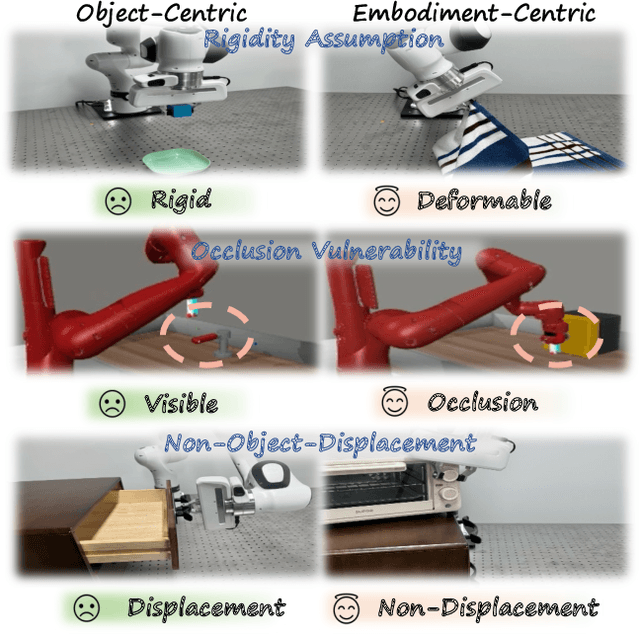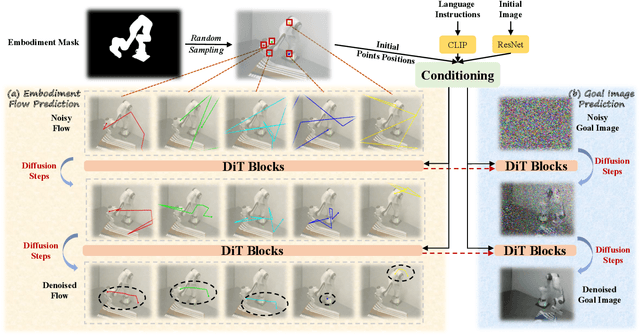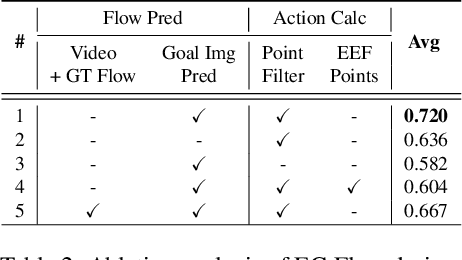Yan Huang
EgoDemoGen: Novel Egocentric Demonstration Generation Enables Viewpoint-Robust Manipulation
Sep 26, 2025Abstract:Imitation learning based policies perform well in robotic manipulation, but they often degrade under *egocentric viewpoint shifts* when trained from a single egocentric viewpoint. To address this issue, we present **EgoDemoGen**, a framework that generates *paired* novel egocentric demonstrations by retargeting actions in the novel egocentric frame and synthesizing the corresponding egocentric observation videos with proposed generative video repair model **EgoViewTransfer**, which is conditioned by a novel-viewpoint reprojected scene video and a robot-only video rendered from the retargeted joint actions. EgoViewTransfer is finetuned from a pretrained video generation model using self-supervised double reprojection strategy. We evaluate EgoDemoGen on both simulation (RoboTwin2.0) and real-world robot. After training with a mixture of EgoDemoGen-generated novel egocentric demonstrations and original standard egocentric demonstrations, policy success rate improves **absolutely** by **+17.0%** for standard egocentric viewpoint and by **+17.7%** for novel egocentric viewpoints in simulation. On real-world robot, the **absolute** improvements are **+18.3%** and **+25.8%**. Moreover, performance continues to improve as the proportion of EgoDemoGen-generated demonstrations increases, with diminishing returns. These results demonstrate that EgoDemoGen provides a practical route to egocentric viewpoint-robust robotic manipulation.
UltraTac: Integrated Ultrasound-Augmented Visuotactile Sensor for Enhanced Robotic Perception
Aug 29, 2025



Abstract:Visuotactile sensors provide high-resolution tactile information but are incapable of perceiving the material features of objects. We present UltraTac, an integrated sensor that combines visuotactile imaging with ultrasound sensing through a coaxial optoacoustic architecture. The design shares structural components and achieves consistent sensing regions for both modalities. Additionally, we incorporate acoustic matching into the traditional visuotactile sensor structure, enabling integration of the ultrasound sensing modality without compromising visuotactile performance. Through tactile feedback, we dynamically adjust the operating state of the ultrasound module to achieve flexible functional coordination. Systematic experiments demonstrate three key capabilities: proximity sensing in the 3-8 cm range ($R^2=0.90$), material classification (average accuracy: 99.20%), and texture-material dual-mode object recognition achieving 92.11% accuracy on a 15-class task. Finally, we integrate the sensor into a robotic manipulation system to concurrently detect container surface patterns and internal content, which verifies its potential for advanced human-machine interaction and precise robotic manipulation.
CoCoL: A Communication Efficient Decentralized Collaborative Method for Multi-Robot Systems
Aug 28, 2025Abstract:Collaborative learning enhances the performance and adaptability of multi-robot systems in complex tasks but faces significant challenges due to high communication overhead and data heterogeneity inherent in multi-robot tasks. To this end, we propose CoCoL, a Communication efficient decentralized Collaborative Learning method tailored for multi-robot systems with heterogeneous local datasets. Leveraging a mirror descent framework, CoCoL achieves remarkable communication efficiency with approximate Newton-type updates by capturing the similarity between objective functions of robots, and reduces computational costs through inexact sub-problem solutions. Furthermore, the integration of a gradient tracking scheme ensures its robustness against data heterogeneity. Experimental results on three representative multi robot collaborative learning tasks show the superiority of the proposed CoCoL in significantly reducing both the number of communication rounds and total bandwidth consumption while maintaining state-of-the-art accuracy. These benefits are particularly evident in challenging scenarios involving non-IID (non-independent and identically distributed) data distribution, streaming data, and time-varying network topologies.
Interleaved Transceiver Design for a Continuous- Transmission MIMO-OFDM ISAC System
Aug 14, 2025Abstract:This paper proposes an interleaved transceiver design method for a multiple-input multiple-output (MIMO) integrated sensing and communication (ISAC) system utilizing orthogonal frequency division multiplexing (OFDM) waveforms. We consider a continuous transmission system and focus on the design of the transmission signal and a receiving filter in the time domain for an interleaved transmission architecture. For communication performance, constructive interference (CI) is integrated into the optimization problem. For radar sensing performance, the integrated mainlobe-to-sidelobe ratio (IMSR) of the beampattern is considered to ensure desirable directivity. Additionally, we tackle the challenges of inter-block interference and eliminate the spurious peaks, which are crucial for accurate target detection. Regarding the hardware implementation aspect, the power of each time sample is constrained to manage the peak-to-average power ratio (PAPR). The design problem is addressed using an alternating optimization (AO) framework, with the subproblem for transmitted waveform design being solved via the successive convex approximation (SCA) method. To further enhance computational efficiency, the alternate direction penalty method (ADPM) is employed to solve the subproblems within the SCA iterations. The convergence of ADPM is established, with convergence of the case of more than two auxiliary variables being established for the first time. Numerical simulations validate the effectiveness of our transceiver design in achieving desirable performance in both radar sensing and communication, with the fast algorithm achieving comparable performance with greater computational efficiency.
DTPA: Dynamic Token-level Prefix Augmentation for Controllable Text Generation
Aug 06, 2025



Abstract:Controllable Text Generation (CTG) is a vital subfield in Natural Language Processing (NLP), aiming to generate text that aligns with desired attributes. However, previous studies commonly focus on the quality of controllable text generation for short sequences, while the generation of long-form text remains largely underexplored. In this paper, we observe that the controllability of texts generated by the powerful prefix-based method Air-Decoding tends to decline with increasing sequence length, which we hypothesize primarily arises from the observed decay in attention to the prefixes. Meanwhile, different types of prefixes including soft and hard prefixes are also key factors influencing performance. Building on these insights, we propose a lightweight and effective framework called Dynamic Token-level Prefix Augmentation (DTPA) based on Air-Decoding for controllable text generation. Specifically, it first selects the optimal prefix type for a given task. Then we dynamically amplify the attention to the prefix for the attribute distribution to enhance controllability, with a scaling factor growing exponentially as the sequence length increases. Moreover, based on the task, we optionally apply a similar augmentation to the original prompt for the raw distribution to balance text quality. After attribute distribution reconstruction, the generated text satisfies the attribute constraints well. Experiments on multiple CTG tasks demonstrate that DTPA generally outperforms other methods in attribute control while maintaining competitive fluency, diversity, and topic relevance. Further analysis highlights DTPA's superior effectiveness in long text generation.
EC-Flow: Enabling Versatile Robotic Manipulation from Action-Unlabeled Videos via Embodiment-Centric Flow
Jul 08, 2025



Abstract:Current language-guided robotic manipulation systems often require low-level action-labeled datasets for imitation learning. While object-centric flow prediction methods mitigate this issue, they remain limited to scenarios involving rigid objects with clear displacement and minimal occlusion. In this work, we present Embodiment-Centric Flow (EC-Flow), a framework that directly learns manipulation from action-unlabeled videos by predicting embodiment-centric flow. Our key insight is that incorporating the embodiment's inherent kinematics significantly enhances generalization to versatile manipulation scenarios, including deformable object handling, occlusions, and non-object-displacement tasks. To connect the EC-Flow with language instructions and object interactions, we further introduce a goal-alignment module by jointly optimizing movement consistency and goal-image prediction. Moreover, translating EC-Flow to executable robot actions only requires a standard robot URDF (Unified Robot Description Format) file to specify kinematic constraints across joints, which makes it easy to use in practice. We validate EC-Flow on both simulation (Meta-World) and real-world tasks, demonstrating its state-of-the-art performance in occluded object handling (62% improvement), deformable object manipulation (45% improvement), and non-object-displacement tasks (80% improvement) than prior state-of-the-art object-centric flow methods. For more information, see our project website at https://ec-flow1.github.io .
BridgeVLA: Input-Output Alignment for Efficient 3D Manipulation Learning with Vision-Language Models
Jun 09, 2025Abstract:Recently, leveraging pre-trained vision-language models (VLMs) for building vision-language-action (VLA) models has emerged as a promising approach to effective robot manipulation learning. However, only few methods incorporate 3D signals into VLMs for action prediction, and they do not fully leverage the spatial structure inherent in 3D data, leading to low sample efficiency. In this paper, we introduce BridgeVLA, a novel 3D VLA model that (1) projects 3D inputs to multiple 2D images, ensuring input alignment with the VLM backbone, and (2) utilizes 2D heatmaps for action prediction, unifying the input and output spaces within a consistent 2D image space. In addition, we propose a scalable pre-training method that equips the VLM backbone with the capability to predict 2D heatmaps before downstream policy learning. Extensive experiments show the proposed method is able to learn 3D manipulation efficiently and effectively. BridgeVLA outperforms state-of-the-art baseline methods across three simulation benchmarks. In RLBench, it improves the average success rate from 81.4% to 88.2%. In COLOSSEUM, it demonstrates significantly better performance in challenging generalization settings, boosting the average success rate from 56.7% to 64.0%. In GemBench, it surpasses all the comparing baseline methods in terms of average success rate. In real-robot experiments, BridgeVLA outperforms a state-of-the-art baseline method by 32% on average. It generalizes robustly in multiple out-of-distribution settings, including visual disturbances and unseen instructions. Remarkably, it is able to achieve a success rate of 96.8% on 10+ tasks with only 3 trajectories per task, highlighting its extraordinary sample efficiency. Project Website:https://bridgevla.github.io/
Enhancing Marker Scoring Accuracy through Ordinal Confidence Modelling in Educational Assessments
May 29, 2025Abstract:A key ethical challenge in Automated Essay Scoring (AES) is ensuring that scores are only released when they meet high reliability standards. Confidence modelling addresses this by assigning a reliability estimate measure, in the form of a confidence score, to each automated score. In this study, we frame confidence estimation as a classification task: predicting whether an AES-generated score correctly places a candidate in the appropriate CEFR level. While this is a binary decision, we leverage the inherent granularity of the scoring domain in two ways. First, we reformulate the task as an n-ary classification problem using score binning. Second, we introduce a set of novel Kernel Weighted Ordinal Categorical Cross Entropy (KWOCCE) loss functions that incorporate the ordinal structure of CEFR labels. Our best-performing model achieves an F1 score of 0.97, and enables the system to release 47% of scores with 100% CEFR agreement and 99% with at least 95% CEFR agreement -compared to approximately 92% (approx.) CEFR agreement from the standalone AES model where we release all AM predicted scores.
Dyn-D$^2$P: Dynamic Differentially Private Decentralized Learning with Provable Utility Guarantee
May 10, 2025Abstract:Most existing decentralized learning methods with differential privacy (DP) guarantee rely on constant gradient clipping bounds and fixed-level DP Gaussian noises for each node throughout the training process, leading to a significant accuracy degradation compared to non-private counterparts. In this paper, we propose a new Dynamic Differentially Private Decentralized learning approach (termed Dyn-D$^2$P) tailored for general time-varying directed networks. Leveraging the Gaussian DP (GDP) framework for privacy accounting, Dyn-D$^2$P dynamically adjusts gradient clipping bounds and noise levels based on gradient convergence. This proposed dynamic noise strategy enables us to enhance model accuracy while preserving the total privacy budget. Extensive experiments on benchmark datasets demonstrate the superiority of Dyn-D$^2$P over its counterparts employing fixed-level noises, especially under strong privacy guarantees. Furthermore, we provide a provable utility bound for Dyn-D$^2$P that establishes an explicit dependency on network-related parameters, with a scaling factor of $1/\sqrt{n}$ in terms of the number of nodes $n$ up to a bias error term induced by gradient clipping. To our knowledge, this is the first model utility analysis for differentially private decentralized non-convex optimization with dynamic gradient clipping bounds and noise levels.
Orthogonal Factor-Based Biclustering Algorithm (BCBOF) for High-Dimensional Data and Its Application in Stock Trend Prediction
Apr 30, 2025Abstract:Biclustering is an effective technique in data mining and pattern recognition. Biclustering algorithms based on traditional clustering face two fundamental limitations when processing high-dimensional data: (1) The distance concentration phenomenon in high-dimensional spaces leads to data sparsity, rendering similarity measures ineffective; (2) Mainstream linear dimensionality reduction methods disrupt critical local structural patterns. To apply biclustering to high-dimensional datasets, we propose an orthogonal factor-based biclustering algorithm (BCBOF). First, we constructed orthogonal factors in the vector space of the high-dimensional dataset. Then, we performed clustering using the coordinates of the original data in the orthogonal subspace as clustering targets. Finally, we obtained biclustering results of the original dataset. Since dimensionality reduction was applied before clustering, the proposed algorithm effectively mitigated the data sparsity problem caused by high dimensionality. Additionally, we applied this biclustering algorithm to stock technical indicator combinations and stock price trend prediction. Biclustering results were transformed into fuzzy rules, and we incorporated profit-preserving and stop-loss rules into the rule set, ultimately forming a fuzzy inference system for stock price trend predictions and trading signals. To evaluate the performance of BCBOF, we compared it with existing biclustering methods using multiple evaluation metrics. The results showed that our algorithm outperformed other biclustering techniques. To validate the effectiveness of the fuzzy inference system, we conducted virtual trading experiments using historical data from 10 A-share stocks. The experimental results showed that the generated trading strategies yielded higher returns for investors.
 Add to Chrome
Add to Chrome Add to Firefox
Add to Firefox Add to Edge
Add to Edge